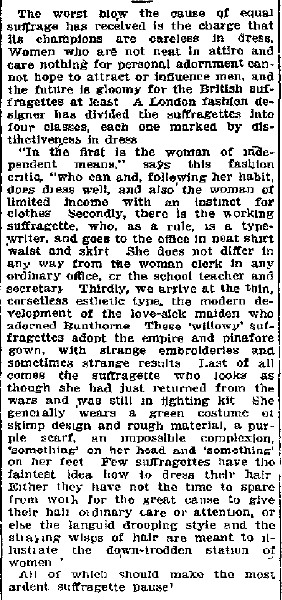In The Washington Post, November 1, 1909, an unidentified “London fashion designer” gets bitchy and judgmental about how suffragettes dress. Yes, even though I don’t know if this possibly fictitious designer is male or female, I say “bitchy.” For even should ye olde fashion designer be both real and male (gay stereotypes aside), the fact that this item appeared at all in the Society pages, is proof of the bitch factor.
But perhaps most importantly are the number of appearances of myths, stereotypes, and general mean spiritedness which are preyed and played upon today:
The worst blow the cause of equal suffrage has received is the charge that its champions are careless in dress. Women who are not neat in attire and care nothing for personal adornment cannot hope to attract or influence men, and the future is gloomy for the British suffragettes at least. A London fashion designer has divided the suffragettes into four classes, each one marked by distinctiveness in dress.
“In the first is the woman of independent means,” says this fashion critic, “who can can and following her habit does dress well, and also the woman of limited income with an instinct for clothes Secondly, there is the working suffragette, who, as a rule, is a typewriter, and goes to the office in neat shirt waist and skirt She does not differ in any way from the woman clerk in any ordinary office, or the school teacher and secretary Thirdly we arrive at the thin, corsetless esthetic type, the modern development of the love-sick maiden who adorned Bunthorne These ‘willowy’ suffragettes adopt the empire and pinafore gown, with strange embroideries and sometimes strange results Last of all comes the suffragette who looks as though she had just returned from the wars and was still in fighting kit She generally wears a green costume of skimp design and rough material, a purple scarf, an impossible complexion, ‘something’ on her head and ‘something’ on her feet Few suffragettes have the faintest idea how to dress their hair Either they have not the time to spare from work for the great cause to give their hair ordinary care or attention, or else the languid drooping style and the straying wisps of hair are meant to illustrate the down-trodden station of women”
All of which should make the most ardent suffragette pause!
